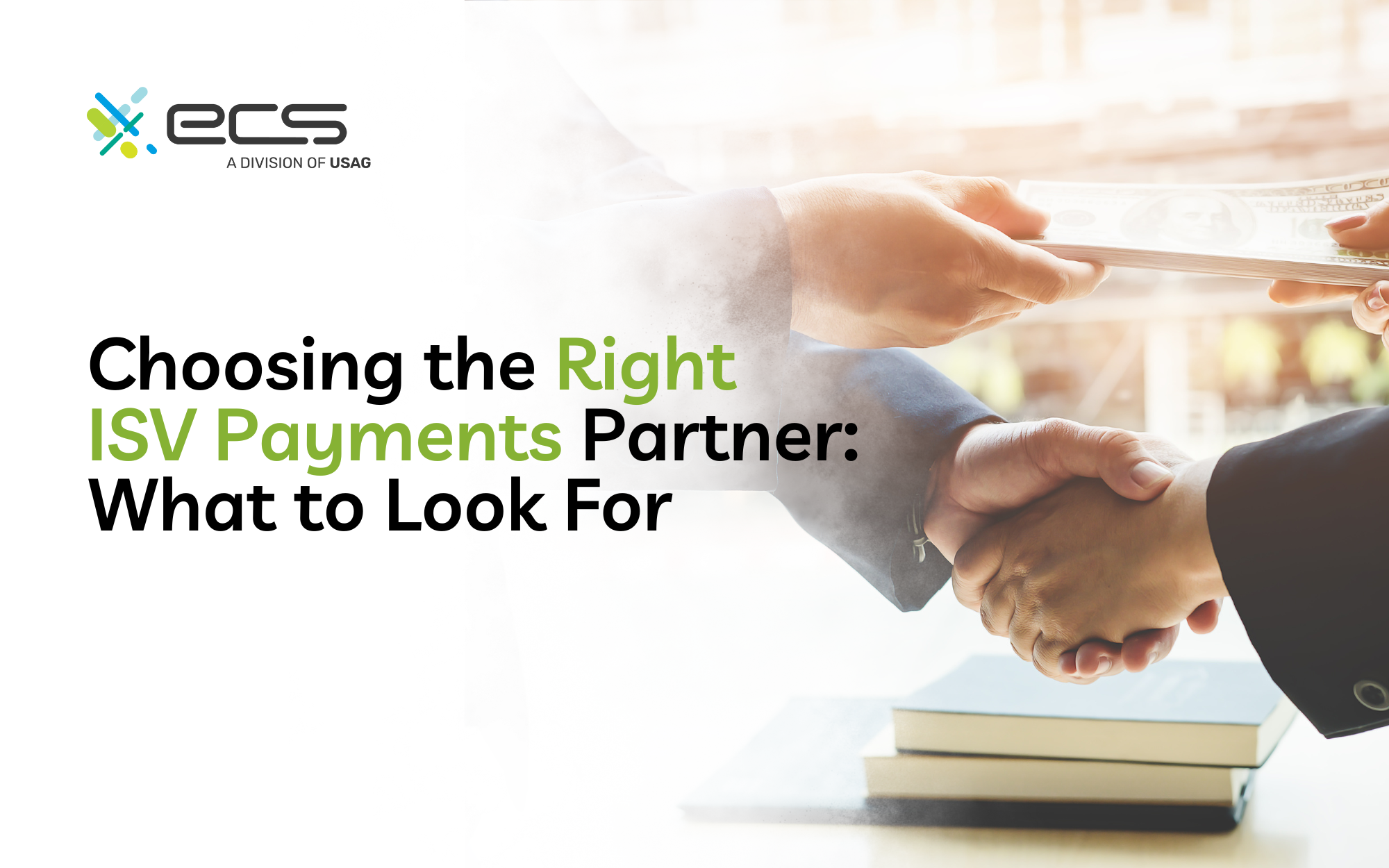If you’re building a SaaS platform or vertical software product, there’s a tipping point where customer demand for a smoother billing or checkout experience starts to clash with your development bandwidth and that’s when payment integration stops being optional. It becomes strategic.
Your users want less friction. Your competitors are already offering one click transactions, automated billing, and seamless reconciliation. And if you’re not, you’re leaving revenue, retention, and relevance on the table.
That’s why choosing the right ISV payments partner can fundamentally reshape your product roadmap. The right partner won’t just help you process payments. They’ll unlock embedded revenue streams, reduce churn through a better payments experience, and help you launch faster with scalable infrastructure.
If you’re weighing how to integrate payments into your software or how to get more out of the integration you already have this guide walks through what matters most: from APIs and white labeling to monetization and long term scalability.

What is an ISV (Independent Software Vendor)?
An Independent Software Vendor (ISV) is a company that builds and sells software, often vertical specific, intended for end users. ISVs operate independently of hardware manufacturers or traditional IT firms. SaaS companies, point of sale (POS) platforms, CRMs, appointment booking apps, and industry specific ERPs are all examples of ISVs.
What makes modern ISVs stand out is their shift toward becoming all in one platforms. Instead of just offering operational software, more ISVs are embedding payments and financial tools into the product experience.
And that’s not just for convenience it’s about control, customer data, new revenue, and better customer experiences.
Why Payment Integration is Critical for SaaS and Software Platforms
When payments are tightly embedded in your software, they become part of the core user experience. You’re no longer forcing customers to bolt on third party tools or manually reconcile transactions in another system.
That’s critical for:
- User experience: frictionless, on platform payments improve conversion.
- Cash flow: faster processing means quicker payouts to your users.
- Data ownership: you gain insights from every transaction.
- Customer retention: users are less likely to churn when their financial operations run through your platform.
According to the U.S. Chamber of Commerce, more than 80% of consumers now expect contactless or integrated digital payment options. Without built in payment system functionality, you’re not just behind, you’re giving your competitors a head start.

The Role of an ISV Payments Partner
Your ISV payments solutions partner is more than just a processor. Think of them as a payments infrastructure layer for your software, offering everything from merchant onboarding to bank account settlement, PCI compliance, transaction processing, and reporting dashboards. Forbes reports that the embedded finance market is already worth $84 billion and growing rapidly, especially in vertical SaaS.
A solid partner will also give you tools for managing the merchant experience: white labeled portals, integrated reconciliation, robust reporting, and scalable onboarding.
How Payment Processors Work with ISVs
When an ISV partners with a payment processor, they’re integrating the processor’s capabilities directly into their software via an API or SDK. That means your customers can accept credit and debit cards, ACH, or contactless payments all without leaving your platform.
Choosing a payment processor can be a tough process. But, the processor needs to be equipped to handle the complex backend of:
- Acquiring bank relationships
- Merchant account underwriting
- PCI compliance
- Transaction routing
- Settlement to bank accounts
Meanwhile, you control the front end experience. A good integrated payment solution will make your product feel cohesive and reliable, not like a bolt on widget.
The Benefits of Integrated Payment Partnerships for ISV Software Platforms
In the SaaS world, user experience isn’t a feature, it’s the product. If your customers are forced to leave your platform to process a payment, if checkout is clunky, or if transactions frequently fail, they’ll start shopping for a better solution. And odds are, they’ll find one.
That’s why SaaS payment integration is more than a convenience, it’s a competitive necessity. Integrated payment solutions don’t just enable customers to transact; they create seamless, in app payment flows that enhance core platform functionality. We’re talking about features like:
- Real time visibility into transaction processing
- Stored credit and debit cards for repeat customers
- Automated reporting and reconciliation
- Recurring billing and dynamic pricing models
- Real time payouts to your customer’s bank account
This level of embedded functionality dramatically improves the user experience. And when you remove friction from the payment flow, you not only make your users happier, but you also help them convert more business.
Forbes reports that the embedded finance market hit $84.12 billion in 2023 and is projected to grow at a staggering CAGR of 32.81% through 2033. That kind of growth represents a massive opportunity for independent software vendors (ISVs) who get ahead of the curve by embedding payment technology into their platforms now.
But the value isn’t limited to end users. Embedded payments are a growth engine for ISVs themselves. One study from Bain & Company shows that improving customer retention by just 5% can boost profits by 25% to 95%. Integrated payments are often the sticky feature that keeps users engaged long term.
Here’s what embedded payments offer both parties:
For your customers:
- Streamlined, faster checkouts
- Fewer manual errors from data re entry
- Real time insights into cash flow and payment status
For your platform:
- Higher transaction volume flowing through your system
- Stickier product experience, increasing customer retention
- New revenue through residuals, interchange share, and value added services
Integrated payments don’t just make your software more useful, they make it more profitable. And with the right ISV payments partner, this functionality seamlessly integrates into your application without adding complexity to your dev team’s workload.

Key Qualities to Look For in a Payments Partner
Seamless API and SDK Integration
A modern partner should offer RESTful APIs and developer friendly SDKs with up to date documentation and sample code to accelerate go to market timelines.
White Label Capabilities and Branding Control
The payment experience should look and feel like your own product, not a third party plugin.
Data Security and PCI Compliance
Compliance isn’t optional. Your partner must offer PCI DSS Level 1 compliance and tools to help you and your merchants stay secure.
Transparent Pricing and Revenue Sharing
Avoid opaque pricing models. Look for interchange plus or flat rate models with clear revenue sharing terms so you’re not left guessing at your residuals.
Reliable Support and Onboarding Assistance
From integration to merchant underwriting, choose a partner that offers dedicated technical support and an onboarding team familiar with ISV workflows.
Customization and Developer Support
Importance of Detailed Documentation and Sandbox Environments
Well documented APIs with sandbox access mean your dev team can build, test, and iterate faster. A lack of documentation is a red flag.
Case by Case Flexibility for Vertical Specific Needs
Your industry may require custom flows for underwriting, fraud controls, or reporting. Choose a partner who doesn’t force one size fits all templates on your product.
Scalability and Long Term Partnership Potential
Ability to Grow with Your Software Platform
Can the partner support your growth from 100 merchants to 10,000? Do they offer multi location support, multi currency settlement, or international expansion?
Metrics to Evaluate for Longevity
- Uptime SLAs
- Product roadmap alignment
- API version stability
- Customer support responsiveness
As McKinsey notes, embedded finance is projected to account for up to 25% of all retail banking revenue by 2030. ISVs that plan ahead will ride that wave.
Revenue Opportunities for ISVs
Monetizing Payments Through Residuals and Value Added Services
ISVs can generate ongoing revenue by sharing in the merchant account fees or offering premium financial services (e.g., next day payouts, analytics, lending).
Some ECS ISV partners generate six and even seven figure residuals just from payment volume flowing through their platform.
Examples of Successful ISV + Payment Processor Partnerships
Check out ECS Payments’ case studies to see how software platforms in retail, healthcare, and field services have unlocked new revenue and expanded their user base by embedding payments.

Choose for Fit, Not Just Features
Selecting a payments partner is one of the most important product decisions your team will make. Get it right, and you’ll improve your payments experience, grow transaction volume, and unlock serious revenue. Get it wrong, and you’ll waste months on reintegration, customer support tickets, and lost merchants.
Vet partners based on performance, not promises. Look for clear APIs, reliable onboarding, flexible pricing, and long term scalability.
Because in 2025, payment integration isn’t just a feature, it’s a growth engine.
Want to dig deeper? Read more expert backed insights on ISV integrations and payment strategies.
